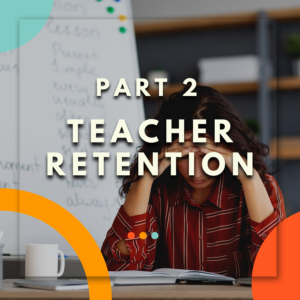States Addressing the Teacher Shortage, Part 2: Retention
States seeking to solve the teacher shortage, in addition to facing the long-developing crisis of teacher recruitment, are now also facing a crisis of teacher retention.
 Especially in the wake of COVID-19, keeping the teachers hired in any given year is an uphill battle.
Especially in the wake of COVID-19, keeping the teachers hired in any given year is an uphill battle.
The National Education Association (NEA) – the nation’s largest teacher’s union – surveyed its members in February 2022 and found that “more than half (55%) of members plan to leave education sooner than planned” and that “the top issue facing educators right now is burnout.”
States across the nation are seeking solutions to improve teacher retention, with research and state examples providing a wide array of options and approaches to choose from. Two key strategies emerging from those examples are:
- Supporting career development opportunities through mentoring programs
- Improving working conditions for teachers by:
- increasing teacher capacity by providing support staff and reasonable class sizes
- increasing teacher opportunities to participate in the school decision-making process
- supporting administrator training and development
Higher rates of teacher turnover are typically seen in newer, less experienced teachers; 19-30% of new teachers are estimated to exit the workforce within their first five years.
To address the high attrition rate among these newcomers, schools across the nation are using experienced teachers to help train and support new teachers through mentoring and induction programs. Supporting new teachers through mentorship and pairing new teachers with veteran teachers not only supports the skill development of new teachers, but can also ensure higher retention rates. One federal study found that 92% of first-year teachers who had mentors returned to the classroom for a second year. Further, by providing experienced teachers with the opportunity to mentor, state and local leaders can provide professional career ladders that further support retention of veteran teachers.
State Examples
Colorado established a grant program to support various school initiatives to retain teachers, including mentorship programs. The legislature found that, based on current research and a state-wide study, mentorship can support the retention of new teachers through peer support and the retention of veteran teachers through the creation of career advancement opportunities.
Similarly, North Carolina established a task force to study teacher and school administrator effectiveness and compensation. The task force found that mentorship opportunities offered teachers important career pathways through which they could earn additional compensation while improving the teachers around them and sharing their knowledge with peers.
Striving to retain effective teachers, Minnesota encourages districts to develop mentoring programs not limited to new teachers. The state seeks to further retain and support teachers from marginalized communities or special populations. Mentorship supports are extended to teachers of color, teachers who are American Indian, teachers in license shortage areas, teachers with special needs and experienced teachers requiring peer support. To enhance mentor representation, the state also allows districts to provide additional stipends as incentives to mentors of color or who are American Indian.
Other notable state examples include:
- Connecticut’s mentorship program allows retired teachers who have completed the mentor teacher training to serve as mentors for beginning teachers. The State Board of Education also awards a “distinguished educator designation” to highly trained educators.
- Florida expands opportunities for military veterans to obtain certification while pursuing a bachelor’s degree. During that time, these beginning teachers are provided with experienced teachers to mentor them for their first two years.
- Iowa requires the completion of a “beginning teacher mentoring and induction program,” or teaching experience at a school utilizing the state’s framework for teacher career paths, leadership roles and compensation.
- Virginia funds a mentor program to support new professionals in transitioning into full-time teaching, including pre-service teachers as well as new teachers.
Policies tailored to improve teachers’ professional working experience and conditions can support teacher recruitment and retention. Policies can approach this objective in a variety of ways, such as supporting administrator training and development, providing adequate support staff and reasonable class sizes, and increasing teacher opportunities to participate in the decision-making process.
Administrator training and development
“Administrative support is often the top reason teachers identify for leaving or staying in the profession, or in a given school, outweighing even salary considerations for some teachers,” according to an analysis from the Learning Policy Institute. Similarly, the University Council for Educational Administration notes that administrative support and strong school leadership positively influence teacher working conditions, and in turn increase retention. Both organizations recommended state and local policies that support the hiring, preparation, and professional development of school administrators.
Illinois and Vermont provide specific mentor programming for new principals.
- Illinois requires new principals to participate in a mentorship program during their first year, with an optional second year. The program is funded through a state grant. If funds are insufficient, the program becomes voluntary with priority given to the highest-need schools.
- Vermont requires districts hiring new principals to ensure they receive mentoring that is aligned with best practices and research-based approaches during the first two years of employment. Districts may fund the program in a variety of ways, including allocated district professional development funds and grant or state funds for mentoring supports.
Class Size and Support Personnel
Class size and availability of support personnel also drive teacher retention rates. A recent
Recent state efforts to address these issues include:
- Nevada amended the K-3 student-teacher ratio determination to specifically exclude administrators/licensed personnel (counselors, coaches and special education teachers), ensuring that the class sizes are based on the primary teacher, not support staff.
- Virginia gives schools the option to either hire qualified/licensed counselors not certified for education or enter into contracts to expand and meet the demand for student counseling services. In addition, the state requires each school board to provide at least three specialized student support positions per 1,000 students.
- The Washington legislature recognizes the need for physical, social, and emotional support staff in schools, especially in response to the pandemic, and established prototypical funding formula to increase their hiring throughout the state.
Teacher Opportunities to Participate in Decision-Making
Finally, in a 2018 policy brief, EdPolicy Works notes that including teachers in the decision-making process can improve teacher retention.
Various states include teacher representation at the state level to evaluate or oversee the administration of education and teacher-related policies. Similarly, states seek to provide teacher roles in the decision-making process at the district and school level as well.
- In Delaware, the Redding Consortium for Educational Equity, which recommends policies and actions to the state on local educational improvement, includes two appointed teacher members.
- Illinois, Kentucky and Utah utilize school councils for localized decision making. In Kentucky and Utah, teacher council members are elected by their peers, and in Illinois they are appointed by the school board in consideration of staff recommendations. Councils such as these generally advise and set school-based policies, such as curriculum, discipline, and spending. They also play a key role in developing and administering the school improvement plans.
While policies to support and improve teacher retention — for both new and experienced teachers — continue to be developed and tested around the country, efforts to control class sizes, develop strong support staff, and bring teachers into decision-making processes are quickly gaining consensus as best practices for addressing teacher retention. When combined with formal mentoring programs, these programs increase the retention of new teachers by providing critically important early-career support while also increasing the retention of experienced teachers by providing career advancement opportunities. All of these policies, in the end, aim to stem the loss of educators in the workforce by improving working conditions and reducing turnover.
These practical, research-based approaches offer useful tools and strategies for state leaders facing education workforce shortages.
CSG East will continue to analyze national trends and share best practices on these topics.
Members are welcome to email us with questions, suggestions, and research requests, and are invited to attend our 2023 annual meeting in Toronto, Ontario, where our Education and Workforce Development committee will meet once again to share ideas and hear from experts in the field.
This two-part series explores how states across the country have worked to address teacher shortages by improving both recruitment and retention. The series focuses on the following policy considerations:
Part 1: States could increase teacher recruitment by:
- Developing sustainable talent pipelines:
- Reducing financial barriers.
- Providing a greater number of on-ramps, such as apprenticeships and residencies.
Part 2: States could improve teacher retention by:
- Supporting career advancement opportunities for those in the education field, including career ladders and mentorship opportunities.
- Improving working conditions:
- Supporting administrator training and development
- Increasing teacher capacity by providing support staff and reasonable class sizes
- Creating avenues for educators to participate in school decision-making processes.





